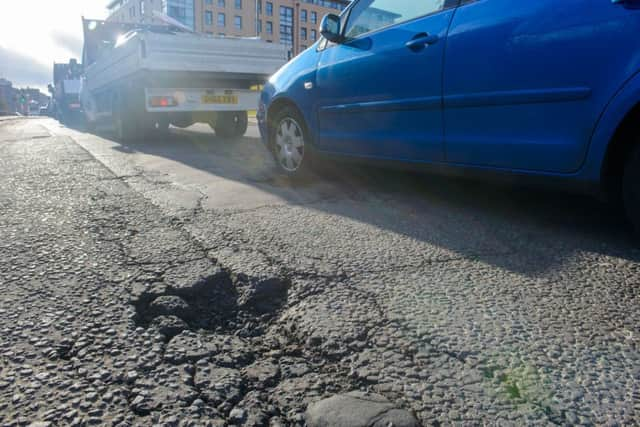Robots could fill Scotland's potholes in a minute


A fleet of autonomous road vehicles or drones will travel around cities identifying cracks in roads and pavements and fixing them before potholes develop.
In just one minute, a robot with an attached 3D printer will be able to spray asphalt into a crack in the road to repair it.
Advertisement
Hide AdAdvertisement
Hide AdExperts said that in towns and cities across Britain the autonomous vehicles or drones could operate at night, meaning there would be little disruption to traffic flows or the road network.
A study released late last year showed Scottish roads were littered with the highest number of potholes in the UK and would stretch to a combined depth of nearly four miles.
A total of 154,310 potholes were reported to Scottish councils lin 2016 – around 16,000 more than the next worst-hit region, the south-west of England.
Professor Mark Miodownik, from the University College London, said Leeds City Council was working with a team of engineers and designers to pioneer the idea of “self-repairing cities”.
He told the Cheltenham Science Festival that Britain’s road network was falling apart due the backlog of repairs and the authorities did not have the resources to take preventative measures.
“Our idea is that when these small cracks happen, we want to be able to see them – a drone flying around the road network would see them – and another drone would land and repair them,” he said.
“You do it at night and we can do it in about a minute. You stop over the crack, you repair the crack and it’s done.
“You could stop the traffic at 4am, hold it up for a minute.
Advertisement
Hide AdAdvertisement
Hide Ad“For motorways it is a different problem, but for roads in Cheltenham and bigger cities, I think night-time autonomous vehicles would have almost no impact on traffic.”
Prof Miodownik said the technology could also be used in the construction industr, as a firm in Holland has attached a spot-welding machine to a robot and has been building a structure.
“There are lots of technical issues to solve, but we are in the phase now where robots are not a big part of construction,” he said.
“But it seems undoubtedly our future that when you look at future construction sites you will see robots building a building or a bridge.
“What that then means is that the repair of that building or bridge will be able to be done by robots because the design will have already taken to account that robots need access.”
Prof Miodownik added: “This is going to be a big future for us all. What is immediately possible now for ‘self-repairing cities’ is an exciting prospect in all of our lives.
“This is probably become a reality. There are all sorts of ethical and moral issues in putting robots in a city environment.
“Unless the public and policy-makers are involved right at the beginning of this technology, which is now, the chances of it advancing to the point where they feel excluded or we can see a future that no-one really wants is high.”
